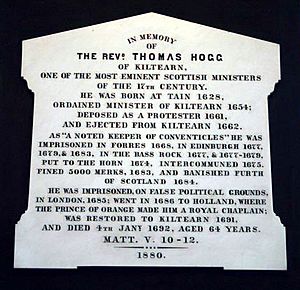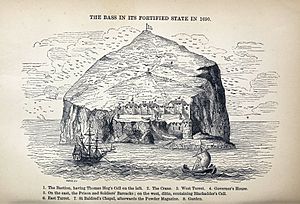Thomas Hog facts for kids
Quick facts for kids Thomas Hog |
|
|---|---|

Plaque to Rev. Thomas Hog, Evanton Parish Church
|
|
| Personal details | |
| Born | early 1628 |
| Died | 4 January 1692 |
| Denomination | Christian |
Thomas Hog (1628–1692) was an important Scottish minister in the 1600s. He was known for his strong beliefs and for facing many challenges because of them. He is often called Thomas Hog of Kiltearn.
Contents
Early Life and Ministry
Thomas Hog was born in early 1628 in Tain, Ross-shire, Scotland. His family were Highlanders, a bit above average in their community.
He went to Tain grammar school. Later, he studied to become a minister at Marischal College in Aberdeen. He earned his Master of Arts degree in 1650.
In 1654, he became a chaplain for John, Earl of Sutherland. A chaplain is a minister who works for a specific person or group. On October 24, 1654, he became the minister of Kiltearn. This church was near Dingwall, by the Cromarty Firth.
Standing Up for His Beliefs
Thomas Hog lived during a time when there were big disagreements in the Scottish church. He strongly supported a group called the "Protesters." Because of this, he was removed from his job as a minister in 1661. This is called being "deposed."
Even after being deposed, Thomas Hog continued to preach. He held secret church meetings called "conventicles" in his home and other hidden places. One famous spot was "Hog's Strype" in the Hills of the Arstill.
In 1668, church leaders found out he was still preaching. He was put in prison in Forres. But he was later set free with the help of the Earl of Tweeddale.
Imprisonment and Exile

Thomas Hog kept preaching, even after being released. In 1675, the government issued "letters of intercommuning" against him. This meant no one was allowed to help or shelter him.
In January 1677, he turned himself in. He was sent to the Edinburgh Tolbooth prison. Then, he was moved to the Bass Rock, a famous island prison. He became very sick there.
A doctor asked for his release, but a powerful bishop named Archbishop Sharp refused. Sharp said Hog could do more harm from his chair than twenty others. Hog was kept in a very small, dirty cell.
Despite the harsh conditions, he surprisingly got better. He was later moved back to Edinburgh Tolbooth. In July 1679, he was finally set free. He had to promise to stay within a certain area.
However, in 1683, he was accused again of holding secret meetings. He was fined a large sum of money. He decided to leave Scotland and was banished in March 1684.
Life in Exile and Return
Thomas Hog first lived in Berwick-upon-Tweed. In 1685, he went to London, planning to sail to America. But he was arrested because people thought he was involved in a rebellion.
He was released and escaped to Holland. There, the Prince of Orange made him one of his chaplains.
Thomas Hog returned to Scotland in 1688. In 1690, a new law allowed him to become the minister of Kiltearn again. He had predicted this would happen thirty years earlier!
He died on January 4, 1692, after a long illness. He asked to be buried under the church door at Kiltearn. His tombstone has a special message: "This stone shall bear witness against the parishioners of Kiltearn if they bring an ungodly minister in here."
A memorial church, the Hog Memorial Church, was built in Evanton to honor him.
Family Life
Thomas Hog married a woman who was the sister of John Hay of Inshock and Park. She passed away without having any children.

